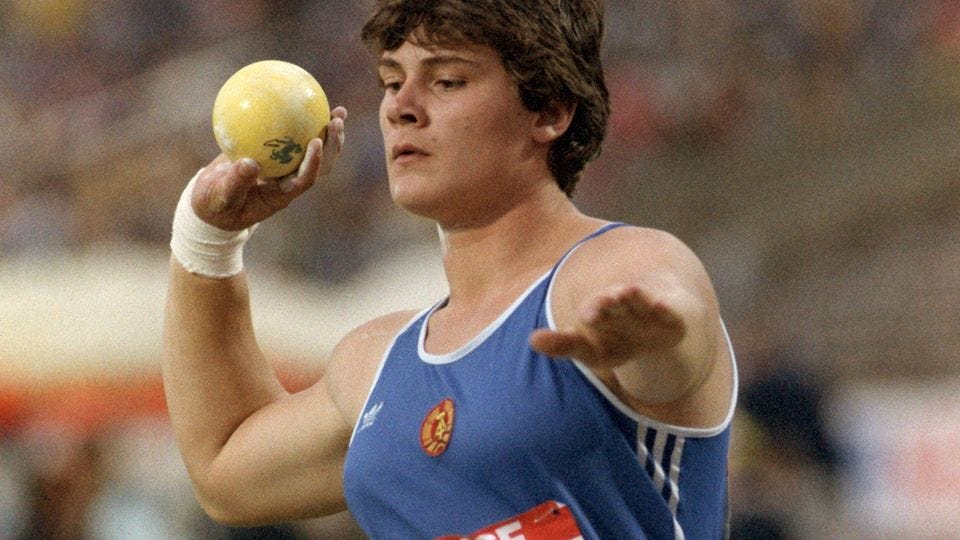The Abolition Of Woman
The biotech of the Left and the Right both treat women as a problem to be solved
***THANK YOU*** to all the subscribers who have joined, read, shared, and supported me over the last year. As I mentioned last week, I’m moving to an “occasional paywall” model for some of what I publish here, as a means of supporting more in-depth writing.
Most of what’s published here will remain free - but if you’re able to, please consider supporting me!

The ‘Roid Olympics
The 2012 Olympics opening ceremony looms large in the British media imagination. Depending on your worldview, it either represented an aspirational “Modern Britain” now disastrously degraded, or the last hurrah of a twee, hollowed-out fantasy UK whose emptiness has since become painfully apparent. According to the former head of Russia’s “anti-doping” centre, Grigory Rodchenko, though, the 2012 Olympic Games wasn’t the peak of anything. It was a nadir: “the dirtiest in history”.
Rodchenko blew the whistle on the Russian doping scandal in 2017, before fleeing Russia to the US, where he now lives under a witness protection scheme. Prior to this he was a world expert in the development and administration of near-undetectable enhancement drugs, for Russian international athletes.
Could such cloak-and-dagger antics soon be a thing of the past, though? Last week, a competitor event to the Olympic Games announced it had concluded seed-round funding. But unlike the Olympics, the “Enhanced Games” doesn’t insist on doping tests to ensure a level playing-field. On the contrary: the whole point of the event is to see how far human performance can be pushed, by athletes who are openly and unrestrictedly using performance-enhancing drugs.
This week, in response to the announcement, the retired Australian Olympian swimmer James Magnusson said he’d “juice to the gills”, in pursuit of a $1m Enhanced Games prize pot. Anti-doping luminaries are not happy. Grigory Rodchenkov called the event “a danger to health”. And Travis Tygart, CEO of the United States Anti-Doping Agency, told CNN Sport the project was “a dangerous clown show”.
But what has struck me both about the project, and the response to it, is a different echo from the legacy of Olympic doping: the sense in which transhumanist efforts to engineer perfect adult athletes blur, at the event horizon, with the transhumanist efforts to engineer phenotypic sex.
Queering the Games, Gaming the Queer
The image that leads this essay is of Heidi Krieger, an East German shot-putter who won the European women’s championships in 1986, and was later revealed to have been subjected to an extreme doping regime. While just a teenager, scientists gave Krieger what they called “vitamin pills”, but which she later discovered were Oral-Turinabol, an anabolic steroid. Krieger later described how her physique changed, and she grew more attracted to women - eventually, in 1997, opting for full medical transition, and taking the name “Andreas”.
In this new adopted male identity, would Krieger celebrate the work of the Human Rights Campaign? Certainly this leading American nonprofit might celebrate her as “LGBT”: a pioneer of the sexual rights programme that follows ineluctably from the 1960s transhumanist turn. As I’ve set out in Feminism Against Progress, the register used to advocate for this first transhumanist wave - the reproductive technology movement and the cyborg rights they enable - is of “freedom”, “oppression”, “identity” and - especially - “bodily autonomy”.
No wonder, then, that we find much the same the register employed by the Enhanced Games. The site lifts freely, and no doubt intentionally, from the register of post-1960s feminism, talking about “oppression”, “inclusive language”, “bodily autonomy”, and “coming out” as a “proud enhanced athlete”. Lest we miss the no doubt deliberate resonance, the Enhanced Games also appears to have lifted its branding almost wholesale from the Human Rights Campaign.
Where the HRC’s logo is two horizontal yellow bars on a deep cobalt-blue background, denoting an “equals” sign, the Enhanced Games has darkened the blue, added an extra horizontal bar to create a stylised “E”, then added a “plus”. It’s as though they’ve taken the HRC’s “equals” iconography and added: “some are more equal than others”.
But this makes sense. Both the HRC and the Enhanced Games are promoting the same broader policy programme: freedom-enhancing biotech. They just offer different rationales for doing so. In both cases, biomedical interventions are framed as a right, in the name of “bodily autonomy”. The difference is that where the HRC proposes this in the name of sameness - for example ensuring women’s ability to compete on the same professional playing-field as men, by eliminating pregnancy risk - the Enhanced Games emphasises competitive excellence: a biotech quest for the Übermensch.
The Enhanced Games’ founder, Aron D’Souza, makes this point explicitly. Speaking to CNN Sport, he declared that doping-free sport is “histories in the past” and that’s not what consumers want. What they want, he says, is supermen: “They’re interested in superheroes and technology in the future. And this is literally what we are bringing to a reality.”
Anyone still feeling enthused by recent victories in the war on gender ideology should probably stop reading now. For in Aron D’Souza’s quest for sporting supermen, I see the other “pole” of a key political battleground in the emerging post-liberal era: one that, in fact, represents less an opposing view than the twin face of a new bipartisan consensus on transhumanism.
And as I’ll set out below, whether it’s promoted in the name of sameness (the “Left” in old money) or excellence (the new “Right”) it will offer the same bleak choice for women: productise yourself, or be erased.
Keep reading with a 7-day free trial
Subscribe to Mary Harrington to keep reading this post and get 7 days of free access to the full post archives.





